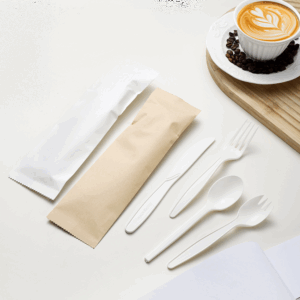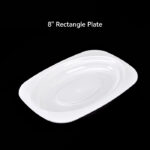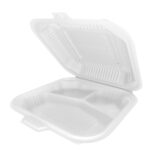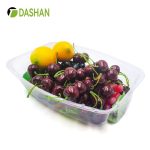Quick Summary
This article compares cornstarch bioplastics and CPLA. Cornstarch is cost-effective and eco-friendly for cold packaging, while CPLA offers higher heat resistance and durability for hot foods. Both are compostable, with the choice depending on performance needs and budget.
Introduction
“Have you ever noticed that some biodegradable utensils withstand heat better than others?”
“Yes, I have! I wonder what materials they’re made of.”
This conversation reflects a growing interest in sustainable materials. Two prominent biodegradable materials in the market are Cornstarch-based bioplastics and CPLA (Crystallized Polylactic Acid). Understanding their differences is crucial for making informed choices in sustainable product development.
Cornstarch
Source and Production
Cornstarch is extracted from the endosperm of corn kernels. The production process involves:
-
Steeping: Soaking corn kernels to soften them.
-
Grinding: Milling the softened kernels to separate components.
-
Separation: Using centrifugation to isolate starch.
-
Drying: Removing moisture to obtain the final powder form.
This process utilizes renewable resources, making cornstarch a sustainable choice.
Properties and Uses
-
Biodegradability: Cornstarch-based products decompose naturally under industrial composting conditions.
-
Renewability: Derived from plants, reducing reliance on fossil fuels.
-
Applications: Used in packaging materials, disposable cutlery, and as a thickening agent in foods.
Environmental Advantages
Utilizing cornstarch reduces greenhouse gas emissions and supports the circular economy by returning organic matter to the soil upon decomposition.
Usage Scenarios
-
Food Industry: Packaging for dry goods, bakery items, and snacks.
-
Agriculture: Biodegradable mulch films.
-
Retail: Eco-friendly shopping bags and containers.
CPLA (Crystallized Polylactic Acid)
Source and Production
CPLA is synthesized by polymerizing lactic acid, produced through the fermentation of sugars from renewable resources like corn starch. The crystallization process enhances heat resistance and mechanical strength.
Properties and Uses
-
Biodegradability: Compostable in industrial facilities, breaking down into water and carbon dioxide.
-
Thermal Resistance: Withstands higher temperatures, suitable for hot food and beverages.
-
Applications: Used in hot beverage cups, lids, cutlery, and 3D printing filaments.
Balancing Sustainability and Performance
CPLA offers a compromise between environmental responsibility and functional performance, catering to applications requiring higher durability and heat resistance.
Usage Scenarios
-
Food Service: Hot beverage cups, lids, and utensils.
-
Healthcare: Disposable medical tools and containers.
-
3D Printing: Filaments for creating durable prototypes.
Comparative Analysis
Environmental Impact
Both materials are biodegradable and derived from renewable resources. However, CPLA’s enhanced properties come from additional processing, which may involve higher energy consumption.
Performance Differences
-
Heat Resistance: CPLA outperforms cornstarch in high-temperature applications.
-
Mechanical Strength: CPLA offers greater durability, making it suitable for products requiring structural integrity.
Cost and Application Areas
-
Cornstarch: More cost-effective, ideal for cold food packaging and disposable items.
-
CPLA: Higher cost due to processing, preferred for hot food containers and reusable items.
Comparative Table
| Feature | Cornstarch | CPLA |
|---|---|---|
| Source | Corn kernels | Fermented sugars from corn starch |
| Biodegradability | Industrial composting | Industrial composting |
| Heat Resistance | Low | High |
| Mechanical Strength | Moderate | High |
| Cost | Lower | Higher |
| Ideal Applications | Cold food packaging, disposable items | Hot food containers, reusable items |

Expert Insights and Scientific Data
Industry Trends
-
The global cornstarch packaging market is projected to reach USD 1,145 million by 2033, growing at a CAGR of 17.3% .
-
The biodegradable plastic market is expected to grow at a CAGR of 16.2%, reaching USD 25.1 billion by 2032 .
Scientific Studies
-
A study published in Nature highlighted that certain formulations of cornstarch-based bioplastics exhibited significant improvements in tensile strength and biodegradability .
-
Research indicates that while both materials are biodegradable, their degradation rates vary based on environmental conditions and material composition .
FAQ
1. What is the main difference between cornstarch and CPLA cutlery?
Cornstarch cutlery is typically made from modified starch and may contain additives for durability, while CPLA (crystalized PLA) is a heat-resistant bioplastic derived from corn-based PLA and processed to withstand higher temperatures.
2. Is CPLA better than cornstarch in heat resistance?
Yes, CPLA is heat-resistant up to around 85–90°C, making it more suitable for hot foods and beverages. Cornstarch-based items may deform under high heat unless reinforced with other materials.
3. Are both cornstarch and CPLA compostable?
Both materials are industrially compostable under high-heat composting conditions, typically breaking down within 90 to 180 days. However, they may not degrade effectively in home compost systems.
4. Which is more eco-friendly—cornstarch or CPLA?
Both are plant-based and renewable, but CPLA has a more complex production process. Cornstarch is often viewed as simpler and more natural, while CPLA offers better performance under stress.
5. Can cornstarch and CPLA products be microwaved?
CPLA products are generally safe for limited microwave use due to their crystallized structure. Cornstarch cutlery, on the other hand, is usually not microwave-safe unless specifically labeled.
Conclusion
Both cornstarch and CPLA offer sustainable alternatives to traditional plastics, each with unique advantages. The choice between them should be guided by specific application requirements, cost considerations, and environmental impact goals.
📚 References (10 Sources)
-
Smith, M. & Rujnic-Sokele, M.
A Comparative Study of Bioplastics: PLA vs Starch-based Bioplastics
https://doi.org/10.1016/j.proeng.2013.09.149 -
Auras, R., Lim, L.-T., Selke, S. E., & Tsuji, H.
Poly(lactic acid): Synthesis, structures, properties, processing, and applications
https://onlinelibrary.wiley.com/doi/book/10.1002/9780470649848 -
Petersen, K., Nielsen, P. V., Bertelsen, G., et al.
Potential of biobased materials for food packaging
https://doi.org/10.1016/j.tifs.1999.04.001 -
Chinthapalli, R., Patra, F., & Giri, S.
Performance of cornstarch-based biodegradable packaging for perishables
https://www.sciencedirect.com/science/article/pii/S0144861721001811 -
Narancic, T., et al.
Biodegradable plastic blends create new possibilities for end-of-life management
https://www.nature.com/articles/s41467-018-07832-9 -
European Bioplastics
Bioplastics Market Data 2024 – Global production capacity and material breakdown
https://www.european-bioplastics.org/market/ -
U.S. Department of Agriculture (USDA)
BioPreferred Program: PLA and Starch-Based Product Certification Guide
https://www.biopreferred.gov/BioPreferred/faces/pages/AboutBioPreferred.xhtml -
Market.us Research Team
Biodegradable Plastic Market Size, Trends and Forecast (2024–2032)
https://market.us/report/biodegradable-plastic-market/




